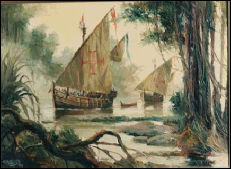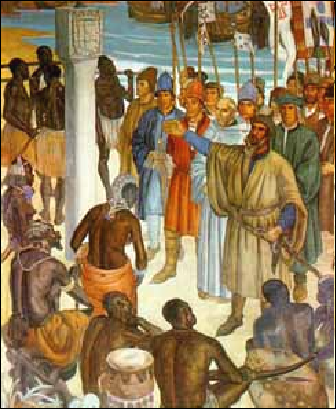


DIOGO CÃO (or CAM) DISCOVERS
THE RIVER CONGO -
xxxxxAs we have seen the Portuguese Prince, Henry the Navigator, son of John I, established a school for seafaring at Sagres in 1419 (H5) and, over a number of years, directed the exploration of the west coast of Africa. By the year of his death, 1460, his navigators had rounded Cape Bojador and reached as far south as Sierra Leone, but no way had been found to reach India by sea. It was John II, the grandson of Henry's brother Edward, who was to resume exploration in the 1470s and achieve this coveted goal.
xxxxxThe
 Portuguese
navigator Diogo Cão (or Cam) was a one of the first explorers
employed by John II.
He is best remembered for being the first European to discover the
mouth of the River Congo (illustrated). This is understandable, but, in fact, in a later
voyage to the west coast of Africa, he managed to reach as far south
as Cape Cross, near Walvis Bay (in today's Namibia) in the
continuing search for this elusive route to the riches of the Far
East.
Portuguese
navigator Diogo Cão (or Cam) was a one of the first explorers
employed by John II.
He is best remembered for being the first European to discover the
mouth of the River Congo (illustrated). This is understandable, but, in fact, in a later
voyage to the west coast of Africa, he managed to reach as far south
as Cape Cross, near Walvis Bay (in today's Namibia) in the
continuing search for this elusive route to the riches of the Far
East.
xxxxxOn
arriving at the mouth of the Congo in 1482 he thought at first that he
had discovered the entrance to the realm of the mystical Prester
John, a legendary Christian prince who was believed to rule over a
powerful empire somewhere in north- One was named Loango, and stretched north and east of the estuary,
and the other Bakongo, which held the land around the mouth of the
river and further south. Despite these native possessions, he at
once claimed the surrounding region as Portuguese territory, and,
before leaving, erected a marble pillar on the river bank (
One was named Loango, and stretched north and east of the estuary,
and the other Bakongo, which held the land around the mouth of the
river and further south. Despite these native possessions, he at
once claimed the surrounding region as Portuguese territory, and,
before leaving, erected a marble pillar on the river bank (
xxxxxDuring his visit, Cão found the natives friendly and eager to trade. Later a Congolese delegation journeyed to see John II, some traders visited the area, and Franciscan missionaries were sent out to preach the gospel. Some three hundred years were to pass, however, before exploration of the Congo region began in earnest.
xxxxxOn reaching Cape Cross during his second voyage, Cão was fairly convinced that he had reached the extreme southern tip of Africa. King John was not so sure, and sent out the navigator Bartolomeu Diaz to explore further. As we shall see, it was he who, in 1488 (H7), was to lead the first European expedition around the Cape of Good Hope and open the sea route to the Far East.
 xxxxxIncidentally, for some years
after Cão’s visit, the River Congo was known as the Rio de Padrao
(“Pillar River”) because of the marble monument he had erected on
the river bank. Later it took the name of Zaire, a word similar to
the native term for “river”. It presumably acquired its present
title from Bakongo, the name of the kingdom which once ruled over
the mouth of the river. Cão erected four marble pillars during his
voyages down the west coast of Africa. Three survived and are now in
museums.
xxxxxIncidentally, for some years
after Cão’s visit, the River Congo was known as the Rio de Padrao
(“Pillar River”) because of the marble monument he had erected on
the river bank. Later it took the name of Zaire, a word similar to
the native term for “river”. It presumably acquired its present
title from Bakongo, the name of the kingdom which once ruled over
the mouth of the river. Cão erected four marble pillars during his
voyages down the west coast of Africa. Three survived and are now in
museums.
xxxxxAs we have seen, it was in 1419 (H5) that the Prince of Portugal, Henry the Navigator, opened a seafaring school at Sagres and began exploring the west coast of Africa. By his death in 1460 his expeditions had reached as far south as Sierra Leone. It was left to King John II to continue his work. One of his first explorers was the Portuguese navigator Diogo Cão. In 1482 he became the first European to discover the mouth of the Congo. He claimed the area for Portugal, and erected a pillar on the river bank as proof of ownership. On a second voyage he reached Cape Cross (in today's Namibia) and thought he had reached the tip of Africa, but, as we shall see, it was Bartolomeu Diaz who, in 1488 (H7) led the first expedition around the Cape of Good Hope.



Acknowledgements
Congo: date and artist unknown. Pillar: illustration of the pillar erected at Cape St. Mary in today’s Angola, artist unknown – possibly from a book published by Cão on his return.
E4-